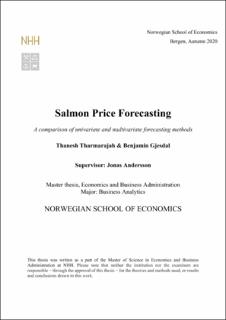Salmon price forecasting : a comparison of univariate and multivariate forecasting methods
Master thesis
Permanent lenke
https://hdl.handle.net/11250/2737169Utgivelsesdato
2020Metadata
Vis full innførselSamlinger
- Master Thesis [4372]
Sammendrag
The salmon industry is becoming an intrinsic part of the Norwegian economy. It is a
commercial activity revolving mostly around a single homogenous product. Consequently,
salmon farmers and other participants along the value chain can gain substantial insight into
how to conduct their business by understanding future spot price movements, primarily since
salmon exhibits considerable price volatility. Therefore, it is of great interest to investigate the
extent to which time series forecasting can support short- and long-term strategic planning 12
months ahead. Previous research, such as A.G Guttormsen (1999), has shown promising results
from applying well known univariate methods. However, most of the studies are outdated,
given market changes. Subsequently, this study will focus on partly proven univariate
forecasting methods and two multivariate methods regarding Atlantic salmon price forecasting
compared to each other and simple benchmarks. The univariate methods are ARIMA and ETS,
while the regression methods applied are GAM and LASSO. We chose GAM and LASSO to
allow for non-parametric and parametric fit, respectively. The univariate models utilized the
spot price of Atlantic salmon, while the multivariate models are supplemented with 20
variables. Each method's accuracy is assessed using mean absolute error and root mean square
error for more straightforward interpretability. Results show that univariate ARIMA and
benchmark naïve with an STL decomposition outperform GAM and LASSO, suggesting
simpler models are perhaps preferable. GAM is superior among the multivariate methods,
which can possibly be attributed to it allowing for non-linear relationships. Despite the poor
performance, the multivariate models indicate the importance of several variables. Although
the models do not provide satisfactory results, it unfolds the possibility of further research using
other regression approaches on Atlantic salmon spot price forecasting.
